Old Red and 27 Seasons of Calving
Photos by Karlie Kafka

On an isolated, quiet hillside in the foothills of the Bear Paw Mountains, a crisp fall breeze rushes by, tousling her wiry, unruly fur. Though once sleek and fiery red, her coat has faded to brick orange after years of exposure to Montana’s frigid winter gales and unrelenting summer sun. Her body’s muscling and fat cover rival those of cows one-fifth her age, but the reality of time is less hidden in the telltale angles and shadows of her face.
There is wisdom in her wide eyes, often contemplative but rarely concerned. As she weaves on through the pasture grasses, her gait is neither swift nor sluggish, and she is keenly aware of the sharp, frosty winds on the horizon.


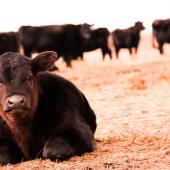

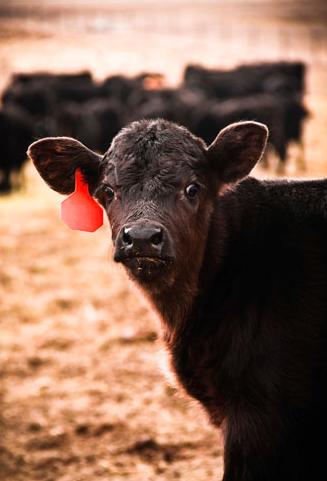
Against the Odds
Haphazard, yet regal, Old Red stands as the indisputable Red Limousin matriarch of our family’s fourth-generation cattle herd. On the verge of her 29th birthday, she is the only animal who has been cared for by three generations of our family. She knew my late grandfather, my father, and is now under the watchful eye of my sister, who happens to be nearly two years younger than Old Red herself.
Owning such an aged cow is an anomaly. Many ranches depend on calf sales as their primary source of income. If a cow fails to produce a calf, she remains an expensive investment but yields no return. Consequently, many ranchers are forced to cull cows as the animals’ ability to produce calves dwindles. Because most beef cows become less productive well before their tenth year, keeping older cows is an uncommon practice.
Well, Old Red didn’t get that memo. During the 2017 calving season, we will witness the birth of her 26th calf. Against all odds, indeed.
Now or Never
Physically and emotionally, calving season is arguably the most strenuous time of year for ranching operations. Producers who are unable to foster healthy, strong calves could quickly face financial ruin. Simultaneously, gestating cattle require extra care and monitoring to ensure they have the greatest likelihood of producing viable offspring. Combine these issues with unpredictable weather, and it becomes quite easy to understand why calving season leaves many producers longing for the days of summer grazing.
Braving the Storm
In order to minimize hay expenses and to maximize the use of pasture grasses, many Montana cattle producers choose to have their livestock calve beginning late in February and ending in early May. Unfortunately, the weather that often accompanies late winter and early springtime in our area is not always conducive to bringing new life into the world. In fact, it can sometimes be downright demonic. Polar temperatures, blinding snow, and instantaneous freezing are not simply inconveniences for Montana ranchers — they guarantee death for newborn calves left unprotected.

While the styles and numbers of shelters available will vary between ranches, most area producers agree that having a dry space with wind protection is essential for newborn calves.
Our operation utilizes a large coverall barn capable of holding approximately 100 cows, as well as a small adjacent heated barn to provide shelter for more high-risk cases. Because the large barn does not have the capacity to hold our entire herd, only those who are closest to giving birth and those with newborns can be accommodated. This requires us to remain especially vigilant in our monitoring of the herd in order to ensure no cow is left to give birth outside.
With subzero temperatures also comes frozen water — the bane of many caretakers’ existences. Repairing broken lines or fighting with malfunctioning stock water heaters can consume a significant portion of the day. Those who rely on ponds and reservoirs as water sources regularly have to cut or auger through thick ice multiple times per day in order to hydrate their livestock.
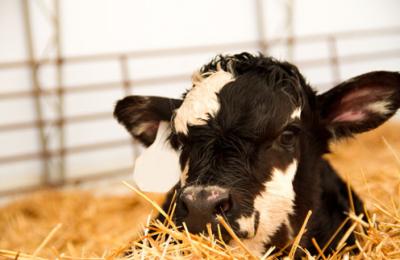
Feeding the Masses
Throughout the winter months, each cow needs to be provided with approximately 30 pounds of feed hay every 24 hours. In a single day, our ranch utilizes just less than three tons of forage. Depending on the size of the herd, it quickly becomes evident why so many layered stacks of bales dot the landscape throughout our state.
Preferences for additional supplements and feedstuffs vary between producers, and each ranch’s specific feeding program will determine the means by which food is dispensed to the herd. We choose to feed our cows a combination of forages in rows using a large tractor and bale scattering equipment. Conveniently, we are able to utilize the same equipment to cover the floor of our barn with straw bedding for added warmth and moisture absorption.
Lending a Hand
Even under the best of care, cows and their calves sometimes need help to get through the birthing process. As many ranchers can attest, this usually occurs during the darkest hours of the morning, when no one else is available to assist, most likely during the middle of a blizzard.
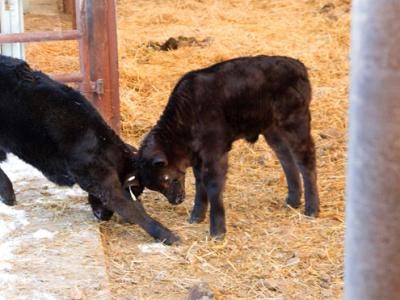
Various signals can indicate a cow in distress, with some being subtler than others. While most births occur without problem, the need for intervention is not uncommon. Many producers will coax the cow into a head catch pen for examination. This allows the cow to remain standing, but restricts her movement.
The caretaker can then assesses the position of the calf by reaching into the cow’s vaginal cavity — yes, often shoulder-deep — and feeling for identifying features such as hooves, knees, a snout, or a tail. Repositioning a calf lodged firmly inside a restless, uncomfortable 1,400 pound animal can easily become a physical and mental marathon, but it is generally a successful process.
After looping chains above the joints of the calf’s legs, it can usually be eased out of the birth canal by steadily pulling the chains in unison with the cow’s contractions. Helping to bring a calf into the world is never an elegant undertaking, but the reward is well worth the mess.
Punching the Time-Clock
My sister and I not-so-jokingly refer to calving season as “live in the barn time,” and I’m sure countless Montana ranchers will agree. When the slightest bit of complacency could result in severe losses, vigilance is paramount. Unfortunately, this level of commitment can be exhausting, especially for ranches without significant manpower.

Some operations have incorporated surveillance cameras into their monitoring process, which is a goal we have for the future. This technology allows ranchers to observe their barns and corrals from a remote location for a portion of their herd checks, thereby reducing the number of trips into the cold.
For now, my sister and I will each work 14-16 hour shifts every day, ensuring 24-hour coverage of the herd. Our shifts will overlap for four hours, enough time to help each other feed the cows and bed down the barn.
We will call each other out of bed to help pull calves, to make emergency trips to the vet, and to treat minor animal illnesses. Some days we will feel invincible. Some days we will cry about things outside of our control. Some days, we might just sit on the fence and watch Old Red, pampering her 26th baby.

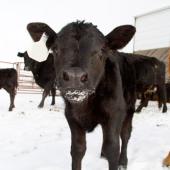
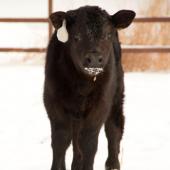
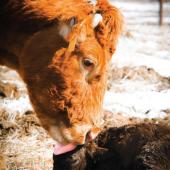
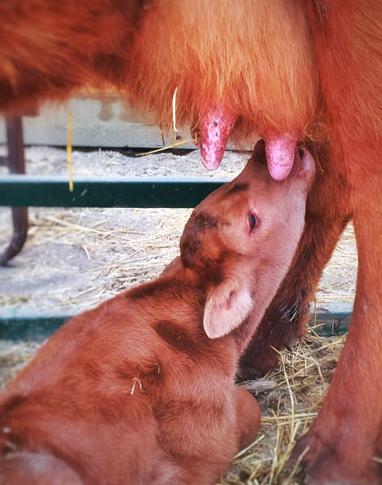
Singing to the Cows
Finding an effective way to gather a herd singlehandedly is no easy task, especially when cattle are spread throughout a large area such as a pasture. Instead of working to push their cattle into a group, some ranchers have found that if they sing, they can compel their cattle to come to them.
Whether the caretaker chooses to use a melody or a certain tone or phrase, cattle tend to respond best when food rewards are occasionally incorporated. Due to their high intelligence, cows quickly associate the specific sound with the potential of treats, and they head over to investigate.
Because this is a conditioned response the cattle associate with their handler, the consistency of the voice and sound emitted are key. If you aren’t the rancher, don’t expect to see amazing results — even if you sing all the right words, the herd just doesn’t know your song.












- Reply
Permalink